Enhancing Shopping Efficiency with Visual Grocery Lists
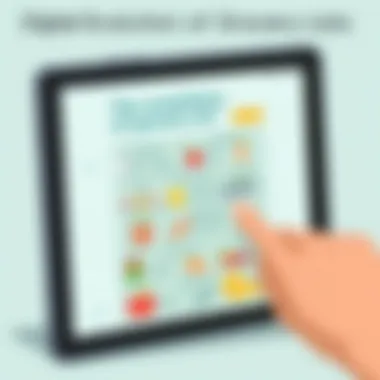
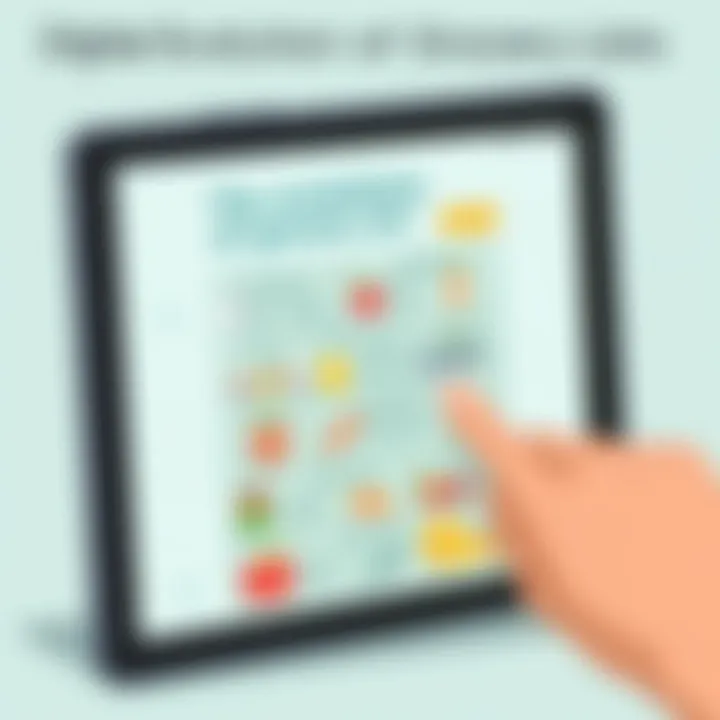
Intro
The hustle and bustle of modern life often leads us to seek ways to make everyday tasks simpler and more efficient. Among these tasks, grocery shopping stands out as a necessary chore that almost everyone has to manage at some point. One innovative approach that's steadily gaining traction is the use of visual grocery lists. These lists, which incorporate images alongside or instead of text, provide a more engaging and intuitive method for organizing shopping trips. Not only do they help in remembering items more effectively, but they also enhance the overall shopping experience, making it less daunting and more enjoyable.
In this article, we will delve into the myriad aspects of visual grocery lists. From understanding how imagery influences comprehension to exploring the latest technological advancements that make these lists more user-friendly, we’ll cover it all. The benefits of using visual artifacts can resonate deeply with families, educators, and individuals alike. With a keen understanding of the psychological effects imagery has on our memory and decision-making, parents can implement these techniques to make grocery shopping a more productive and satisfactory task.
As we navigate through this topic, we'll highlight valuable insights that can assist anyone looking to streamline their shopping experience while also understanding the bigger picture behind the use of visuals in task management.
Understanding Visual Grocery Lists
Visual grocery lists are more than just a tool for jotting down what you need from the store; they represent a significant shift in how we approach the often mundane task of shopping. In a world where we are bombarded with information on a daily basis, finding efficient ways to process and recall that information has become paramount. By utilizing visual elements, such as images, icons, and color coding, these lists help individuals of all ages streamline their shopping experience and minimize cognitive overload.
In exploring visual grocery lists, we’ll delve into what they are, their purpose, and how they've evolved over time. This discussion sheds light on how effective these lists can be not only for individuals engaged in shopping but also for families and educators looking to enhance memory retention and reduce stress.
Definition and Purpose
A visual grocery list, in essence, is a shopping list that incorporates graphic elements to represent items, rather than relying solely on written words. The primary purpose of these lists is to enhance comprehension and memory retention, making it simpler for shoppers to remember what they need. Unlike traditional lists, which may overwhelm the reader with text, a visual grocery list creates an engaging and easily navigable format.
For instance, if you’re shopping for apples, instead of just writing “apples,” a visual list could show a picture of an apple alongside the word. This simple substitution leverages the brain's affinity for imagery, making it far easier to recall items when navigating the aisles of a grocery store.
Moreover, the use of visuals can cater to varied shoppers. Young children might recognize a cartoonish image of their favorite cereal, while elderly shoppers could benefit from clear, bold visuals that help them navigate their list without straining their eyes. The ultimate aim here is to improve efficiency, allowing users to spend less time looking for items and more time enjoying the experience of shopping.
Historical Perspective
Historically, the notion of lists can be traced back as far as ancient civilizations, when people documented their needs to barter and trade. However, the concept of visual lists specifically is a relatively modern intervention. Before the advent of visually-oriented lists, most people employed plain text or handwritten notes, which, while functional, didn’t account for the cognitive differences in how information is processed.
With the advancement of technology and graphic design, particularly through applications and other tech platforms, visual grocery lists have become increasingly popular. The early days of grocery shopping were simplistic in nature, but as marketing and consumer behavior evolved, the need for more effective communication techniques emerged. Visual aids became not just a tool for organization, but a method to engage shoppers in a new way.
For instance, the rise of nutritional awareness and dietary preferences has seen people looking for ways to better understand what they consume. Visual grocery lists often come into play, helping to visually categorize items based on dietary restrictions or goals, like low-carb or vegan. This tailored approach to shopping has become a focal point for many individuals striving for better health outcomes.
In summary, understanding visual grocery lists is a multifaceted exploration of our relationship with shopping, memory, and the impact of visuals on our daily routines. By embracing this innovative technique, individuals can not only make the shopping experience smoother but also enrich their understanding of the task at hand.
Benefits of Visual Grocery Lists
Visual grocery lists offer a range of significant advantages that can transform the way we approach shopping. As daily life becomes increasingly complex, enhancing our efficiency during routine tasks like grocery shopping can yield noticeable benefits. This section delves into the key perks associated with using visual grocery lists. Focusing primarily on improved memory retention and a lighter mental load, we can see how a simple visual shift makes a world of difference.
Enhanced Retention of Information
The impact of visual elements on memory is worth noting. When it comes to visual grocery lists, the brain naturally engages with images. A study found that the human brain processes images 60,000 times faster than text. By incorporating pictures of items alongside their names, shoppers can effectively imprint information in their minds.
Imagine a grocery list featuring a colorful photo of fresh broccoli as opposed to just writing the word "broccoli". The visual representation anchors the concept in a shopper's mind, reducing the chances they'll forget to grab it.
"People remember 80% of what they see and only 20% of what they read."
This underscores the value of imagery in supermarket navigation, particularly for families with children.
Parents can include fun graphics or icons for items, making the list not only functional but engaging for kids. This technique serves a dual purpose: teaching children about grocery items while ensuring that families stick to their intended shopping. Using visuals is a tried-and-true method to strengthen memory pathways, ensuring nothing is missed when the shopping cart rolls through the aisles.
Reduced Cognitive Load
Cognitive load refers to the total amount of mental effort being used in the working memory. Visual grocery lists, with their categorization and imagery, can help lighten this load significantly. By breaking down the grocery list into easily identifiable sections, shoppers can navigate stores more efficiently.
For example, organizing items by categories such as dairy, produce, or snacks allows people to focus on one group at a time rather than juggling a lengthy list in their heads. Rather than constantly switching gears in memory, visual lists allow the mind to stay in a single track, making the shopping experience smoother and more focused.

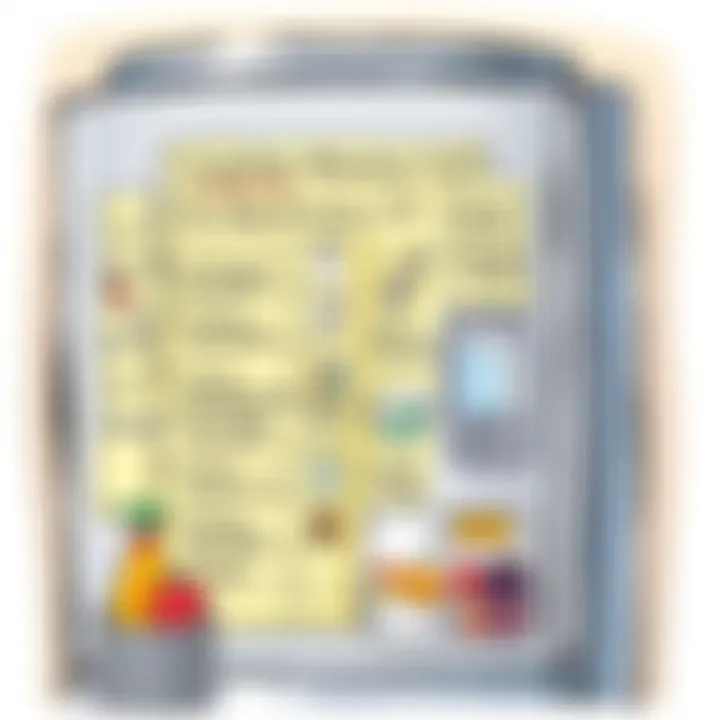
Using symbols or colors to signify different categories can further aid in quickly identifying what is needed. A bright yellow sticker for dairy can indicate urgency, while a mellow green may indicate items that can be picked up later. This approach minimizes decision fatigue, empowering shoppers to make quicker decisions without second-guessing their selections.
In a world where time is precious, reliant on numerous tasks each day, adopting visual grocery lists can maximize efficiency, making the shopping phase smooth and orderly.
Designing an Effective Visual Grocery List
Creating a visual grocery list is more than just a means to an end; it’s a functional tool that can significantly enhance the shopping experience. An effective grocery list serves specific purposes, such as ensuring nothing gets forgotten and making the process smoother. In today’s busy world, efficiency in grocery shopping is critical for families, educators, and anyone looking to optimize their time. By focusing on elements like color coding, illustrations, and user-friendly layouts, one can transform a mundane task into a more engaging and organized task.
Color Coding and Categorization
Color coding is not just about aesthetics; it’s a practical strategy that helps in organizing items intuitively. By assigning specific colors to different categories of groceries—like fruits, vegetables, dairy, or snacks—one can quickly scan the list and locate items in the store. This method can also aid in reducing the time spent wandering the aisles, which may lead to impulsive buying. For instance, a green highlight can signal fresh produce, while yellow might indicate pantry staples.
Consider these points for effective color coding:
- Intuition: Choose colors that make sense for each category. Using familiar colors can aid memory recall.
- Simplicity: Keep the palette limited to avoid confusion, perhaps three to four colors max.
- Visibility: Ensure that the colors contrast well with the background of the list for easy readability.Equipping your grocery list in this manner can save time and brainpower, as one doesn't have to think too hard about where each item is located in the store.
Incorporating Illustrations
Illustrations can be a game-changer in the design of a grocery list, especially for families with children or for those who are visual learners. By adding small images of the items next to their names, one nurtures a connection between the visual representation and the actual item. This can decrease the likelihood of forgetting items and simplify the identifying process at the store.
Think about these aspects when incorporating illustrations:
- Relevance: Use clear, recognizable images. A picture of a carrot should be instantly identifiable; no room for ambiguity here.
- Size: Ensure that the illustrations are not too large, which could clutter the list, but just big enough to be distinguishable at a glance.For instance, you might find a small illustration of a carton of milk next to the word "milk". This not only makes the list child-friendly, but it can also be beneficial for individuals who might struggle with reading.
User-Friendly Layout
When it comes to grocery lists, layout is paramount. A clean, uncluttered design enhances usability. A well-structured layout allows users to navigate their list in a logical order, reducing confusion and frustration while shopping. Organizing the items in a way that mirrors the store layout can contribute to an efficient shopping experience.
To optimize layout, consider these guidelines:
- Sections: Divide the list into sections that align with how the grocery store is organized. For example, all produce items in one section, dairy in another.
- Spacing: Use adequate spacing between items; cramped text can be distracting and tiring to read.
- Formatting: Make use of bullet points for clarity and easy tracking as items are placed in the cart.
In summary, letting good design principles guide the way can lead to a grocery list that is not only practical but also pleasing to the eye. By doing so, one can significantly lessen the strain that shopping often brings.
A thoughtfully designed visual grocery list can make the experience less of a chore and more of a straightforward routine.
By paying close attention to design elements such as color coding, illustrations, and layout, you create a powerful tool that meets both practical needs and enhances the overall shopping experience.
The Role of Technology in Visual Grocery Lists
Technology has become an integral part of modern shopping, shaping how consumers approach their grocery lists. The role of technology in visual grocery lists is multi-faceted, enhancing both efficiency and effectiveness in the shopping experience. Digital advancements have revolutionized the traditional pen-and-paper method, offering features that cater to various needs of today's busy families and individuals.
One notable element of this technological impact is the convenience provided by digital tools. Consumers can now access their grocery lists from mobile devices, making it easier to shop on-the-go. This accessibility is particularly beneficial for parents managing multiple tasks, enabling them to quickly add items they may have forgotten or adjust their needs based on real-time information.
Mobile Applications
Mobile applications serve as powerful allies in managing visually-oriented grocery lists. These apps integrate a variety of features meant to simplify the shopping process. For instance, many applications allow users to create lists visually by simply taking pictures of the items they need. This not only makes it easier to remember what to buy but also aligns with how our brains process visual information more effectively than text alone.
Moreover, a number of grocery list apps support categorization and organization features which make shopping more straightforward. Users can sort items by aisles or categories, ultimately minimizing the time spent wandering through stores looking for products. Some prominent mobile apps also come equipped with
- Collaboration features: Families can share lists, making grocery shopping a collective task. This promotes teamwork among family members and ensures that everyone is on the same page.
- Price comparison tools: Certain apps allow users to compare prices across various stores. Shoppers can quickly find the best deals, saving both time and money.
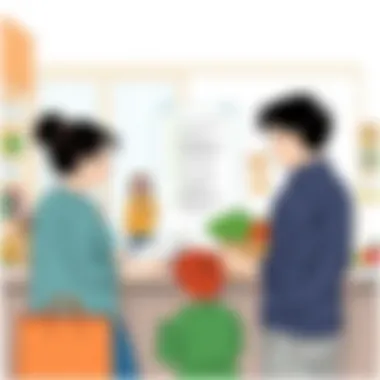
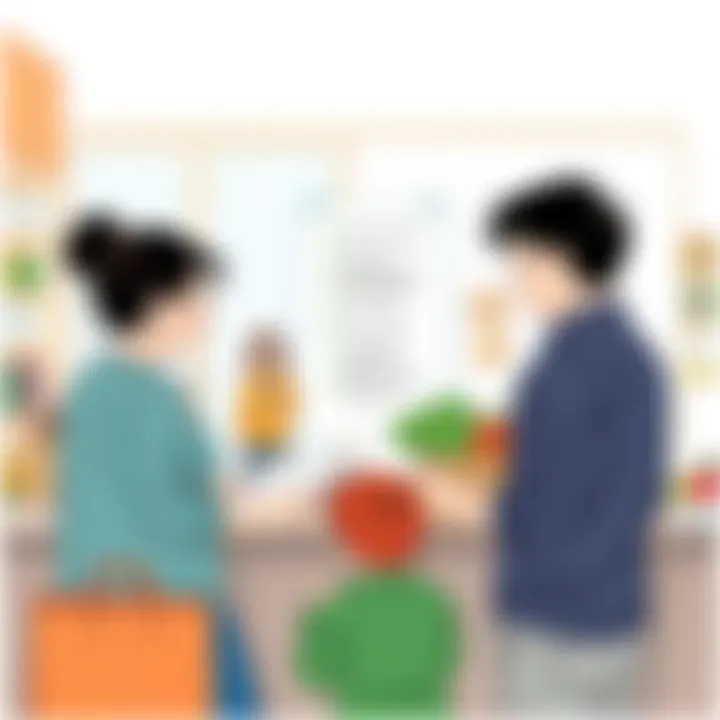
Digital Platforms and Accessibility
In addition to mobile applications, various digital platforms are enhancing the accessibility of visual grocery lists. Online grocery services often provide built-in tools to create and manage shopping lists visually. With just a few clicks, users can add items to their virtual carts, effectively merging convenience with an organized shopping experience.
Furthermore, the rise of smart tech in homes has also played a role in transforming how grocery lists are managed. Smart speakers, like Amazon Echo and Google Home, enable voice-activated grocery list management. Users can add items to their lists simply by speaking, making the process hands-free and easy. This is especially beneficial for caregivers or busy parents juggling tasks while preparing meals.
Both mobile applications and digital platforms not only cater to the growing demand for convenience but also enhance the overall shopping experience by integrating user feedback and preferences. As the landscape of grocery shopping evolves, it's evident that technology is shaping the future in ways that can only improve efficiency and accessibility for everyone.
"Incorporating technology like mobile apps and smart devices into the grocery shopping process creates a more intuitive experience that aligns with our busy lifestyles."
The direction technology is heading in grocery shopping reinforces the importance of visual tools. The seamless integration between physical stores and digital platforms illustrates a forward-thinking approach that benefits consumers immensely.
Case Studies: Visual Grocery Lists in Action
The exploration of visual grocery lists takes a deeper turn when examining real-world applications. Case studies provide solid evidence on how these lists not only enhance shopping efficiency but also cater to specific demographics like families and educational settings. When you see these lists employed effectively, it sheds light on their true potential beyond mere list-making—showing a practical integration into everyday life.
Families Adopting Visual Lists
In households, where time crunch often feels like a second skin, visual grocery lists emerge as a beacon of hope. For instance, picture a busy family of four trying to manage their weekly shopping amidst work and school commitments. By utilizes a visual grocery list, these families find that not only does shopping become quicker, but also more collaborative. Kids can help, picking out items depicted in colorful illustrations instead of reading a cumbersome list of names.
Benefits include:
- Increased Engagement: Children are more likely to enjoy the grocery shopping experience when they can connect visuals with real-world items.
- Better Communication: Families employing visual lists find that it serves as a platform for discussion.
- Enhanced Memory: The blend of images with text helps everyone remember what they went for, decreasing the chances of forgetting essential items.
A family in Minnesota documented their switch to visual lists and noted a significant reduction in impulse buying. They used stickers and colors to indicate needs and wants, limiting unnecessary purchases that used to lurk on the cart. With this visual tool, the children felt empowered and responsible for family tasks, aiding their growth in decision-making over household errands.
Educational Uses in Classrooms
Schools have recognized the value of visual grocery lists as an educational tool, fostering a learning atmosphere that extends beyond traditional methods. In classrooms, teachers have found that using visual lists can stimulate engagement in lessons related to nutrition, budgeting, and responsibilities.
For example, in a lesson on healthy eating, students can create visual grocery lists using images of fruits, vegetables, and other healthy foods. This approach turns a mundane task into an interactive project.
Key takeaways include:
- Improved Understanding: Students grasp concepts like food groups and budgets more easily when they're paired with eye-catching visuals.
- Visual Learning: As many learners absorb information better through images, visual lists prove to be a beneficial tool, especially for younger students or those with learning disabilities.
- Real-World Application: By incorporating grocery shopping scenarios, educators can bridge the gap between theoretical knowledge and practical life skills.
One case study from an elementary school in California reported that the use of visual grocery lists led to improved participation in class discussions about nutrition. Students who had previously struggled to engage learned to articulate their thoughts better after crafting their own lists, enhancing both their confidence and comprehension.
"Visual aids don’t just symbolize learning; they introduce a whole new language that pulls everyone into the conversation," noted one teacher.
These real-life examples highlight how visual grocery lists are not just tools for efficient shopping, but also catalysts for fostering better communication and understanding within various communities. As families and classrooms continue to adopt this method, its benefits radiate far beyond the shopping cart.
Challenges in Implementing Visual Grocery Lists
While visual grocery lists boast numerous advantages, their implementation does not come without challenges. Understanding these hurdles is crucial, as they can significantly impact the effectiveness of this method for streamlining shopping experiences. This section delves into some of the primary obstacles faced by individuals and families when incorporating visual grocery lists into their routines.
Potential Misinterpretations
One of the major hurdles with visual grocery lists is the risk of misinterpretation. When imagery or color coding is involved, the meaning of certain symbols or pictures can be subjective. For instance, a picture of a red apple might represent both ‘apples’ and ‘fruits’ in a family’s mind, potentially leading to confusion in the shopping aisle.
Moreover, toddlers or young children may not associate the visual cues with the intended product. This can result in errands that take longer than anticipated, as parents spend extra time clarifying what a drawing or color means. Miscommunication on a visual list may result not just in purchasing the wrong item but in forgetting essential products altogether.
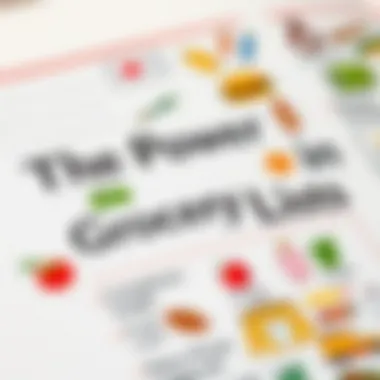

To mitigate this issue, a structured approach should be taken when designing these lists. When crafting a visual grocery list, it can be helpful to include text labels alongside images. This simple step can significantly reduce the possible for confusion. Families might also benefit from having a shared understanding of colors and symbols—creating a legend for family members could promote consistency.
Access to Resources
Another obstacle arises from the accessibility of resources required to create effective visual grocery lists. Not every household has the same access to technology and materials, and this disparity can hinder the efficacy of employing visual aids.
For families with limited access to digital tools, creating an appealing visual grocery list may be an uphill battle. They may rely on traditional pen and paper for their lists, which could limit the visual impact that images offer compared to high-tech applications. Additionally, the lack of readily available artistic resources or printing capabilities could restrict their ability to include vibrant illustrations or charming templates in their lists.
Understanding this gap is essential, particularly from an educational standpoint. Schools can play an important role by providing workshops or materials that assist families in developing their visual grocery lists. Local community centers might organize sessions where parents and children can collaborate on producing these lists using a combination of digital tools and traditional craft materials.
End of Challenges
In summary, while the implementation of visual grocery lists offers a pathway to improved shopping efficiency, significant challenges exist. Misinterpretations of visual cues can confuse users, while limited access to resources can hinder the creation of these lists. These barriers merit attention and understanding from educators and community leaders, ensuring that every family has the ability to adopt and adapt visual grocery lists effectively in their day-to-day lives.
Future Trends in Grocery List Management
The grocery shopping landscape is changing rapidly, all thanks to technology's continuous evolution. As we delve into the future trends in grocery list management, it's clear that the integration of advanced tools is not just a passing fad but a solid direction aimed at improving the efficiency of everyday shopping activities. With the rise of smart devices and artificial intelligence, families, educators, and caregivers are poised to experience a significant transformation in how they handle grocery purchases.
Integration with Smart Home Devices
Imagine walking into your kitchen and seeing your grocery list conveniently displayed on a smart screen or hearing a notification from your voice assistant. The integration of smart home devices, such as Amazon Echo or Google Nest, with visual grocery lists is a game changer. These devices can track your pantry items and send reminders when supplies are running low. Not only do they help to streamline the shopping process, but they also reduce the mental overhead of remembering what’s needed.
Moreover, with voice recognition technology, users can add items to their grocery list hands-free. A busy parent cooking dinner can say, "Hey Google, add eggs to my shopping list," without pausing to write things down. This seamless interaction is particularly useful in multi-tasking environments, typical of homes with children.
- Efficiency: Smart devices save time by automating list updates.
- Convenience: Hands-free additions mean no interruptions while cooking or cleaning.
- Real-Time Updates: Changes made on one device reflect across all connected gadgets, avoiding any mix-ups when others are also adding to the list.
Developments in Artificial Intelligence
Artificial intelligence (AI) is not just a buzzword; it's becoming an integral part of how we manage grocery lists. With AI-driven apps analyzing shopping patterns, users will soon enjoy a more personalized shopping experience. For instance, these smart applications could predict product preferences based on past purchases, suggesting items that often accompany the staple groceries on your list.
This predictive capability doesn’t just enhance decision-making but also minimizes food waste by encouraging consumers to think more critically about their purchases. AI could remind users of their usual purchases while suggesting alternatives if certain items are out of stock or if there are better deals available.
- Tailored Suggestions: AI can learn your preferences and recommend similar products, enhancing your shopping experience.
- Inventory Management: The tech can track what’s left in your pantry and suggest meals you can make with current ingredients.
- Budgeting Help: Users can input budget constraints, and the software can adjust recommendations accordingly, making the grocery experience more economical.
To sum up, as technology continues to advance, so does the potential for enriching the grocery shopping experience. Smart devices and AI are working hand-in-hand, shaping a future wherein grocery shopping is not just a task but an integrated part of our daily lives, designed to help us achieve efficiency while making informed decisions.
Harnessing future trends in grocery list management enables users to enjoy a streamlined, effective shopping experience, transforming a mundane task into something much more manageable and even enjoyable.
Finale and Implications for Users
Summary of Key Insights
- Enhanced Memory Recall: Use of images and colors makes it easier to remember items, which directly correlates to fewer items forgotten at the store.
- Reduced Cognitive Load: Visual aids simplify the decision-making process by breaking down information into digestible formats.
- Increased Involvement: Engaging younger family members in creating visual lists can encourage responsibility and teamwork, fostering essential life skills.
- Adaptability: These lists can easily be tailored to individual needs, whether one is shopping for a large family, or just for oneself, making them versatile across different contexts.
Overall, visual grocery lists have the potential to cater to a wide range of users, from busy parents to teachers looking to educate their students on management.
Encouragement for Adoption in Everyday Life
Implementing visual grocery lists into daily routines can seem like an added task, but the investment of time is often dwarfed by the benefits. Here’s why making the switch could be a game changer:
- Ease of Use: Creating a visual list, whether through hand-drawn illustrations or digital apps, can be as simple as drawing a few basic icons beside the words.
- Fun and Engaging: Especially for families, designing a list can turn into a creative activity where children can participate, making shopping a team effort.
- Build Routine: Establishing the habit of using these lists can make grocery shopping predictably smoother, reducing stress during busy weeks.
As more individuals and families embrace the idea of visual grocery lists, they will likely find that grocery shopping transforms from a chore into a more satisfying task that promotes organization and saves time.
"A picture is worth a thousand words, and for grocery lists, it can be worth a few less trips to the store."
In summary, as we move into an age where the psychological aspects of how we interact with our tasks are increasingly understood, adopting tools like visual grocery lists could very well be the key to more efficient and enjoyable shopping experiences.















